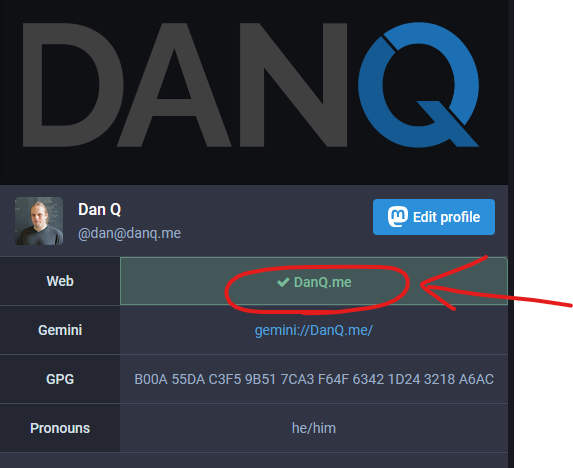Finally got around to implementing a super-lightweight (~20 lines of code, 1 dependency) #spring83 key generator. There are plenty of others; nobody needs this one, but it’s free if you want it:
https://github.com/Dan-Q/spring83-keygen
Finally got around to implementing a super-lightweight (~20 lines of code, 1 dependency) #spring83 key generator. There are plenty of others; nobody needs this one, but it’s free if you want it:
https://github.com/Dan-Q/spring83-keygen
The finger protocol, first standardised way back in 1977, is a lightweight directory system
for querying resources on a local or remote shared system. Despite barely being used today, it’s so well-established that virtually every modern desktop operating system – Windows,
MacOS, Linux etc. – comes with a copy of finger, giving it a similar ubiquity to web browsers! (If you haven’t yet, give it a go.)
If you were using a shared UNIX-like system in the 1970s through 1990s, you might run finger to see who else was logged on at the same time as you, finger
chris to get more information about Chris, or finger alice@example.net to look up the details of Alice on the server example.net. Its ability to transcend the
boundaries of different systems meant that it was, after a fashion, an example of an early decentralised social network!
I first actively used finger when I was a student at Aberystwyth University. The shared central computers osfa and
osfb supported it in what was a pretty typical way: users could add a .plan and/or .project file to their home directory and the contents of these
would be output to anybody using finger to look up that user, along with other information like what department they belonged to. I’m simulating from memory so this won’t be remotely
accurate, but broadly speaking it looked a little like this –
$ finger dlq9@aber.ac.uk
Login: dlq9 Name: Dan Q
Directory: /users/9/d/dlq9 Department: Computer Science
Project:
Working on my BEng Software Engineering.
Plan:
_______
---' ____)____
______) Finger me!
_____)
(____)
---.__(___)
It’s not just about a directory of people, though: you could finger printers to see what their queues were like, finger a time server to ask what time it was,
finger a vending machine to see what drinks it
had available… even finger for a weather forecast where you are (this one still works as shown below; try it for your own location!) –
$ finger oxford@graph.no
-= Meteogram for Oxford, Oxfordshire, England, United Kingdom =-
'C Rain (mm)
12
11
10 ^^^=--=--
9^^^ ===
8 ^^^=== ====== ^^^
7 ====== ===============^^^ =--
6 =--=-----
5
4
3 | | | | | | | 1 mm
17 18 19 20 21 22 23 18/11 02 03 04 05 06 07_08_09_10_11_12_13_14 Hour
W W W W W W W W W W W W W W W W W W W W W W Wind dir.
6 6 7 7 7 7 7 7 6 6 6 5 5 4 4 4 4 5 6 6 5 5 Wind(m/s)
Legend left axis: - Sunny ^ Scattered = Clouded =V= Thunder # Fog
Legend right axis: | Rain ! Sleet * Snow
If you’d just like to play with finger, then finger.farm is a great starting point. They provide free finger hosting and they’re easy to use (try
finger dan@finger.farm to find me!). But I had something bigger in mind…
What if you could finger my blog. I.e. if you ran finger blog@danq.me you’d see a summary of some of my recent posts, along with additional
addresses you could finger to read the full content of each. This could be the world’s first finger-to-WordPress gateway; y’know, for
if you thought the world needed such a thing. Here’s how I did it:
efingerd; I’m using the Debian binaries.
ufw allow 1965; utf reload).
efingerd acts like a “typical” finger server, but it’s highly programmable to make it “smarter”. I:
/etc/efingerd/list to prevent any output from “listing” the server (finger @danq.me).
/etc/efingerd/list and /etc/efingerd/nouser(which are run when a request matches, or doesn’t match, a user account name) with
a call to my script: /usr/local/bin/finger-to-wordpress "$3". $3 holds the username that was requested, so we can act on it.
/usr/local/bin/finger-to-wordpress – a Ruby program that either (a) lists a selection of posts or (b) returns a specific post (stripping the HTML
tags)
In future, I might use some extra tags or metadata to enhance finger-friendly WordPress posts. The infrastructure’s in place already (I already have tags that I use to make
certain kinds of content available only via certain media – shh!). You might rightly as what the point is of this entire enterprise, of course, and you’d be well within your
rights to ask such a question. But I think the best answer available is “because Dan”.
If you want to see my blog in a whole new way, give it a go: run finger blog@danq.me on your computer and follow the instructions.
Over the last three or four years I’ve undertaken a couple of different rounds of psychotherapy. I liken the experience to that of spotting constellations in the night sky.

That’s probably the result of the goal I stated when going in to the first round: I’d like you to help while I take myself apart, try to understand how I work, and then put myself back together again.1 I’m trying to connect the dots between who-I-once-was and who-I-am-now and find causal influences.
As I’m sure you can imagine: with an opening statement like that I needed to contact a few different therapists before I found one who was compatible with my aims2. But then, I was always taught to get three quotes before hiring a professional.

It’s that “connecting the dots” that feels like constellation-spotting. A lot of the counselling work (and the “homework” that came afterwards) has stemmed from ideas like:
I suppose that what I’ve been doing is using the lens of retrospection to ask: “Hey, why am I like this? Is this part of it? And what impact did that have on me? Why can’t I see it?”
When you’re stargazing, sometimes you have to ask somebody to point out the shape in front of you before you can see it for yourself.

I haven’t yet finished this self-analytical journey, but I’m in an extended “homework” phase where I’m finding my own way: joining the dots for myself. Once somebody’s helped you find those constellations that mean something to you, it’s easier to pick them out when you stargaze alone.
1 To nobody’s surprise whatsoever, I can reveal that ever since I was a child I’ve enjoyed taking things apart to understand how they work. I wasn’t always so good at putting them back together again, though. My first alarm clock died that way, as did countless small clockwork and electronic toys.
2 I also used my introductory contact to lay out my counselling qualifications, in case they were a barrier for a potential therapist, but it turns out this wasn’t as much of a barrier as the fact that I arrived with a concrete mandate.
This is a reply to a post published elsewhere. Its content might be duplicated as a traditional comment at the original source.
Let’s not sell Mastodon short here. The service you compare it to – Twitter – solves this problem… but only if you trust Twitter as an authority on the identity of people. Mastodon also solves the problem, but it puts the trust in a different place: domain names and account pages.
If you want to “verify” yourself on Mastodon, you can use a rel=”me” link from a page or domain you control. It looks like this:

A great thing about this form of verification is you don’t have to trust my server (and you probably shouldn’t): you can check it for yourself to ensure that the listed website really does state that this is the official Mastodon account of “me”.
You can argue this just moves the problem further down the road – instead of trusting a corporation that have shown that they’re not above selling the rights to your identity you have to trust that a website is legitimate – and you’d be right. But in my case for example you can use years of history, archive.org, cross-links etc. to verify that the domain is “me”, and from that you can confirm the legitimacy of my Mastodon account. Anybody who can spoof multiple decades of my history and maintain that lie for a decade of indepdendent web archiving probably deserves to be able to pretend to be me!
There are lots of other distributed methods too: web-of-trust systems, signed keys, even SSL certificates would be a potential solution. Looking again at my profile, you’ll see that I list the fingerprint of my GPG key, which you can compare to ones in public directories (which are co-signed by other people). This way you’d know that if you sent an encrypted DM to my Mastodon inbox it could only be decrypted if I were legitimately me. Or I could post a message signed with that key to prove my identity, insofar as my web-of-trust meets your satisfaction.
If gov.uk’s page about 10 Downing Street had profile pages for cabinet members with rel=”me” links to their social profiles I’d be more-likely to trust the legitimacy of those social profiles than I would if they had a centralised verification such as a Twitter “blue tick”.
Fediverse identify verification isn’t as hard a problem to solve as Derek implies, and indeed it’s already partially-solved. Not having a single point of authority is less convenient, sure, but it also protects you from some of the more-insidious identity problems that systems like Twitter’s have.
This checkin to GC9GKJA A Fine Pair # 1625 ~ Eynsham reflects a geocaching.com log entry. See more of Dan's cache logs.
Repaired and replaced. Happy hunting!
This checkin to GC9GKJA A Fine Pair # 1625 ~ Eynsham reflects a geocaching.com log entry. See more of Dan's cache logs.
Tried to replace/repair but muggles were hanging around too close to stealth the cache into position. Going to go find myself some lunch then come back and try again.
This checkin to GC9GTV3 Drive Slowly; Fox Crossing reflects a geocaching.com log entry. See more of Dan's cache logs.
Dropped by on the way back from the school run to check in on this cache. All is well. Also deposited travel bug TB831BW on the next leg of its intergalactic adventure.
This checkin to GC6J5MV Church Micro 9613...West Hanney reflects a geocaching.com log entry. See more of Dan's cache logs.
Had to stand around looking inconspicuous for a while before the geopup and I could retrieve this cache from its hiding place. There’s a lot going on this morning, presumably in anticipation of a Remembrance Sunday service at the church later. The bench across the road provided us with a place to sit and sign while we waited for an opportunity to return it. Amazingly picturesque spot for a lovely cache. FP awarded. TFTC!
This checkin to GC8XMQ8 Rocky Road reflects a geocaching.com log entry. See more of Dan's cache logs.
QEF for the geopup and I while out on a morning walk, although I did get somewhat prickled retrieving the cache from its hiding place. SL, TFTC.
This checkin to GC8XMQN Coming to an end reflects a geocaching.com log entry. See more of Dan's cache logs.
Found the GZ without difficulty and a plethora of great hiding spots, but no luck for me nor the geopup here this morning. The hound enjoyed a quick paddle in the stream at this lovely spot, though, so it’s not a complete failure!
This checkin to GC14QCA TJB Speed Cache reflects a geocaching.com log entry. See more of Dan's cache logs.
Found with the geopup on a morning walk through the woods. Always appreciate a good-sized container. Took travel bug. TFTC.
In the light of the so-called “Twitter migration”, I’ve spent a lot of the last week helping people new to Mastodon/the Fediverse in general to understand it. Or at least, to understand how it’s different from Twitter.1
If you’re among those jumping ship, by the way, can I recommend that you do two things:
The experience has filled me with feelings, for which I really appreciated that Hugh Rundle found such great words to share, comparing the surge of new users to September(ish) 1993:
…
The tools, protocols and culture of the fediverse were built by trans and queer feminists. Those people had already started to feel sidelined from their own project when people like me started turning up a few year ago. This isn’t the first time fediverse users have had to deal with a significant state change and feeling of loss. Nevertheless, the basic principles have mostly held up to now: the culture and technical systems were deliberately designed on principles of consent, agency, and community safety.
…
If the people who built the fediverse generally sought to protect users, corporate platforms like Twitter seek to control their users… [Academics and advertisers] can claim that legally Twitter has the right to do whatever it wants with this data, and ethically users gave permission for this data to be used in any way when they ticked “I agree” to the Terms of Service.
…
This attitude has moved with the new influx. Loudly proclaiming that content warnings are censorship, that functionality that has been deliberately unimplemented due to community safety concerns are “missing” or “broken”, and that volunteer-run servers maintaining control over who they allow and under what conditions are “exclusionary”. No consideration is given to why the norms and affordances of Mastodon and the broader fediverse exist, and whether the actor they are designed to protect against might be you.
…
I’d highly recommend you read the whole thing because it’s excellent.
I genuinely believe that the fediverse is among our best bets for making a break from the silos of the corporate Web, and to do that it has to scale – it’s only the speed at which it’s being asked to do so that’s problematic.
Aside from what I’m already doing – trying to tutor (tootor?) new fediversians about how to integrate in an appropriate and respectful manner and doing a little to supporting the expansion of the software that makes it tick… I wonder what more I could/should be doing.
Would my effort be best-spent be running a server (one not-just-for-me, I mean: abnib.social, anyone?), or should I use that time and money to support existing instances directly? Should I brush up on my ActivityPub spec so I can be a more-useful developer, or am I better-placed to focus on tending my own digital garden first? Or maybe I’m looking at it all wrong and I should be trying to dissuade people from piling-on to a system that might well not be right for them (nor they for it!)?
I don’t know the answers to these questions, but I’m hoping to work them out soon.
It only occurred to me after the fact that I should mention that you can find me at @dan@danq.me.
1 Important: I’m no expert. I’ve been doing fediverse things for about 3 years but I’m relatively quiet on Mastodon. Also, I’ve never really understood or gotten along with Twitter, so I’m even less an expert on that. Don’t assume that I’m an authority on anything at all, and especially not social media.
This is a repost promoting content originally published elsewhere. See more things Dan's reposted.
Just wanted to share with you something I found ages ago but only just got around to mentioning – Julia Evans‘ (of Wizard Zines fame) Debugging Mysteries:
There are five mysteries here right now:
The Case of the Slow Websites
The Case of the Connection Timeout
The Case of the DNS Update that Didn’t Work
The Case of the 50ms Request
The Case of the Failed Docker ConnectionGo back to wizardzines.com
GitHub repository: jvns/twine-stories
Blog post about this project: Notes on building debugging puzzles
Each mystery is a Twine-powered “choose your own adventure” game in which you must diagnose the kind of issue that a software developer might, for real. I think these are potentially excellent tools for beginner programmers, not just because they provide some information about the topic of each, but because they encourage cultivating a mindset of the kind of thinking that’s required to get to the bottom of gnarly problems.
Better yet, she’s open-sourced the entire thing (and I was excited to see she wrote in Twee, which is very dear to my heart).
Unable to sleep, I found myself wondering whether anybody with a retro-hipster vibe had built a smart pocketwatch. All your smartwatch features, but in pocketwatch format.
Then I realised I was describing a mobile phone on a keychain.
This is a repost promoting content originally published elsewhere. See more things Dan's reposted.
We’re going to use ENF matching to answer the question “here’s a recording, when was it was (probably) taken?” I say “probably” because all that ENF matching can give us is a statistical best guess, not a guarantee. Mains hum isn’t always present on recordings, and even when it is, our target recording’s ENF can still match with the wrong section of the reference database by statistical misfortune.
Still, even though all ENF matching gives us is a guess, it’s usually a good one. The longer the recording, the more reliable the estimate; in the academic papers that I’ve read 10 minutes is typically given as a lower bound for getting a decent match.
To make our guess, we’ll need to:
- Extract the target recording’s ENF values over time
- Find a database of reference ENF values, taken directly from the electrical grid serving the area where the recording was made
- Find the section of the reference ENF series that best matches the target. This section is our best guess for when the target recording was taken
We’ll start at the top.
…
About a year after Tom Scott did a video summarising how deviation over time (and location!) of the background electrical “hum” produced by AC power can act as a forensic marker on audio recordings, Robert Heaton’s produced an excellent deep-dive into how you can play with it for yourself, including some pretty neat code.
I remember first learning about this technique a few years ago during my masters in digital forensics, and my first thought was about how it might be effectively faked. Faking the time of recording of some audio after the fact (as well as removing the markers) is challenging, mostly because you’ve got to ensure you pick up on the harmonics of the frequencies, but it seems to me that faking it at time-of-recording ought to be reasonably easy: at least, so long as you’re already equipped with a mechanism to protect against recording legitimate electrical hum (isolated quiet-room, etc.):
Taking a known historical hum-pattern, it ought to be reasonably easy to produce a DC-to-AC converter (obviously you want to be running off a DC circuit to begin with, e.g. from batteries, so you don’t pick up legitimate hum) that regulates the hum frequency in a way that matches the historical pattern. Sure, you could simply produce the correct “noise”, but doing it this way helps ensure that the noise behaves appropriately under the widest range of conditions. I almost want to build such a device, perhaps out of an existing portable transformer (they come in big battery packs nowadays, providing a two-for-one!) but of course: who has the time? Plus, if you’d ever seen my soldering skills you’d know why I shouldn’t be allowed to work on anything like this.